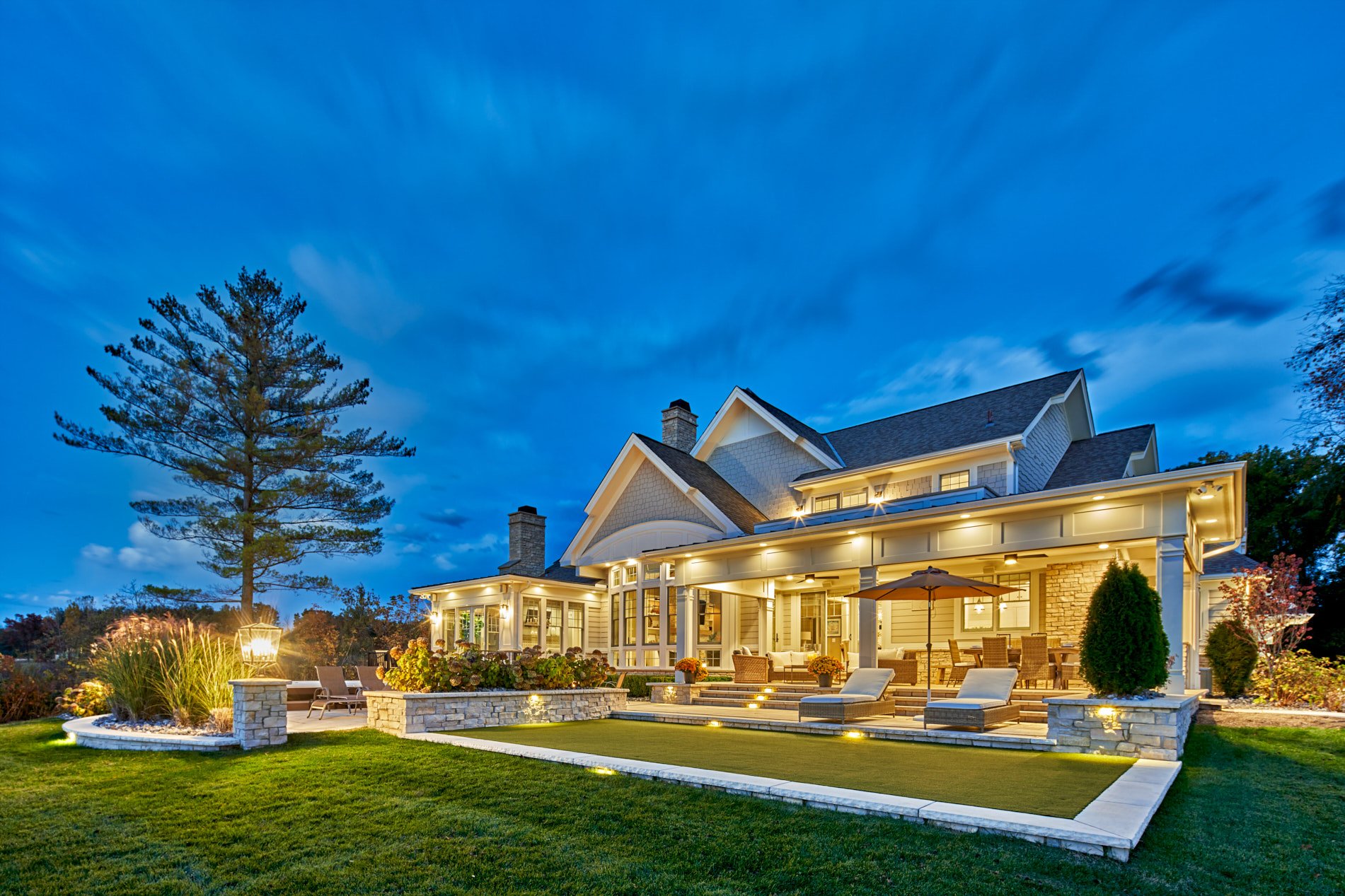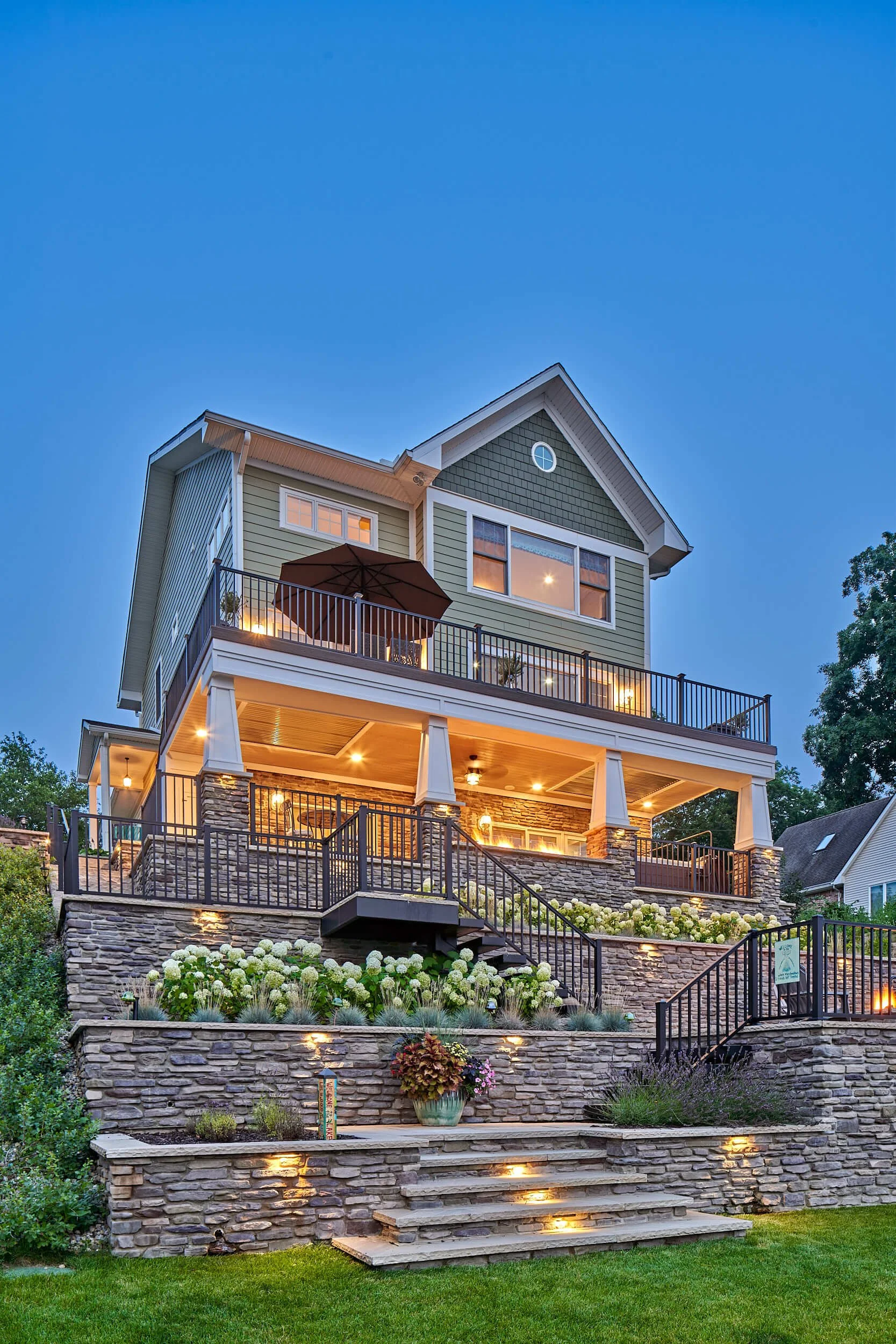How to Design Picture Perfect Landscape Lighting
Pro Tips, Ideas and Inspiration for Landscape Lighting
All About Landscape Lighting
Ventures is a custom design and build company specializing in outdoor living spaces. Our outdoor builds can exceed $1MM with stunning features such as infinity pools, waterfalls and dramatic fire features, yet when asked about the most important element of an outdoor living space, owner Brandon Bertrang immediately responded “Lighting. Bad lighting can ruin an awesome landscape design.”
It would be cruel to drop an ominous statement like that and then leave you in the dark. Here are our pro tips, ideas and of course inspiration for stunning landscape lighting.
Bird-eye view of the landscape lights and fire feature at our Nottingham Pointe project twinkling in the night
How to Design Outdoor Lighting
The most important considerations when you begin planning your landscape lighting are ambiance and functionality. What mood are you hoping to set in your outdoor living space? String lights can be festive and whimsical, Fire & Water bowls add drama and warmth, bullet and up lights can amplify architectural features for a more austere surrounding and RGB lights are a party in themselves.
When it comes to functionality you’ll have to consider how the space will be used. Paths and steps should be lit for safety. Lounge areas require lighting with the right ambiance; you would never put bullet lights on a lounge. An outdoor kitchen requires enough illumination to work effectively but not so much that its distracting.
Bertrang’s design method begins with focal points and moves outward to create a sense of balance “Start with focal features such as trees, plants and columns that you want to highlight. Next move to illuminating walking spaces, accent points in pavers, patios and of course steps. One of my favorite exterior lighting tricks is to embed puck lights in pavers. We drill out a space in the paver and instal puck lights to perfectly illuminate a walkway or patio. When lighting a house, I try to create balance. I like to start at the corners and work my way in” advises Bertrang.
Landscape designer Jake Steward recommends starting with indirect lights, illuminating the space in a soft glow for functionality, then adding pops of drama with up lights on trees and under coping lights. “Avoid any lighting that can cause a glare or will shine directly at ones face” advises Steward “Excessive lights in stairs and deck steps can be a distraction as well. It’s all about balance. You want guest to move through the space safely, but the stairs shouldnt be the visual focal point of your outdoor living space.”
Types of Landscape Lighting
There are several types of landscape lighting, each with its own purpose and personality. Here is a breakdown of several of the most popular styles of outdoor lighting. A good lighting design combines multiple styles to create balance, ambiance and functionality in an outdoor space.
Up Lights: Light fixtures that are installed at ground level with the beam focused upwards. Primarily an aesthetic landscape light, up lights, can have a dramatic effect on a space, casting shadows and adding depth. Up lights are often focused on architectural elements of a home or structure, trees, and other landscape elements you wish to draw attention to.
Downlights: A functional lighting fixture that is mounted high, on a tree or other raised element and shines down, illuminating the space below with a moonlit effect. Often used to illuminate patios, walkways, or garden beds.
Bullet Lights: A lighting fixture that casts a narrow beam of light, directly spotlighting the feature it is focussed on.
Spotlights: A general term for landscape lights that are directed at a single feature. Down lights, up lights, bullet lights and others can be considered spotlights.
Wash Lights: A functional landscape fixture that gives off a soft, diffused light over a larger area. Wash lights are used to illuminate large flat surfaces.
Floodlights: A fixture somewhere between a bullet and wash light; floodlights cast a winder angle beam than a bullet fixture but are brighter and more direct than a wash light.
Puck lights: Small puck-shaped landscape lights with a spike that can be driven into the ground to secure the light in place. Puck lights are often used as an uplight in landscaping beds or to illuminate ornamental trees. At Ventures we love to incorporate them into hardscapes by drilling a hole into patio or walkway pavers and embedding the puck into the hardscape surface.
Well Lights: A lighting fixture that is housed in a waterproof casing and buried in the ground, allowing the light to illuminate above while the fixture itself is hidden from view.
Garden or Path Lights: Lighting fixtures with a Canopy on top of 18- to 24-inch posts that are placed in garden beds or as markers along a path. Unlike other landscape lights, their style and finish are on display.
Market, Bistro or String Lights: Encased wire with multiple bulbs disbursed along the strand. Market lights are often strung overhead on patio and outdoor event spaces or along a latticed roof pergola. Market lights are both functional and aesthetic, adding a festive ambiance to any outdoor space.
Under Coping Lights: Small light fixtures that are installed under the coping lip of retaining walls, raised platforms, and ledges.
Step Lights: A functional light fixture placed under the lip of a step to illuminate the tread.
Overhead or Recessed Lights: Overhead lights are often thought of as interior lights rather than exterior but for covered outdoor kitchens, covered porches, and custom pavilions, overhead or recessed lighting is an integral design element.
RGB Lights: RGB or Red, Green, Blue Lights are bulbs that can change color via remote control. RGB lights can be installed as overhead lights or molding strips and have an immense inpact on the mood of an outdoor space. You can control the color of your lighting with a remote to match your mood, season, holiday, or event theme.
Fire Features: While not technically a landscape light, we had to include fire features because they have a huge impact on both ambiance and functionality. There are so many new styles of fire features, that it would be a shame not to mention them here. From tiki torches to outdoor fireplaces to Fire & Water Bowls, there is no shortage of awesome fire features to add the final touch to your outdoor lighting design.
Pro Tips for a DIY Landscape Lighting
Hiring professionals for landscape lighting is always advised. Electrical features that are exposed to the elements can be hazardous if not properly installed. However, if you are a savvy DIY homeowner with sufficient experience to safely install outdoor lighting, here are a few pro tips to help along the way.
Invest in LED: LED lights are more expensive upfront but the price is well worth it. LED are less expensive to run and will outlast halogen bulbs by years.
Don’t Skimp on the Transformer: “You may not think you need a large transformer initially but investing in one upfront will allow you to expand your outdoor lighting down the line.” advises Steward “Planning ahead can be a huge time and money saver. Think of your ten-year plan for the space and choose a transformer based on the long game. Do you think you’ll want an outdoor TV or projector for movie nights in a few years? Maybe add more lights once you’ve had time to redo your landscaping and add focal points that will really pop with an up light?”
Plan Ahead: Planning ahead can go beyond the transformer. “If you're laying new hardscape elements like a patio or walkway, it can’t hurt to install PVC sleeves for the future” says Steward. Maybe you don’t have the time or money for all your landscape lighting now, but if you think you may add some down the line, having sleeves in place that you can simply fish electrical through when you’re ready is a huge help. It will save you from having to pull up expensive hardscape elements or find ways to work around the existing hardscape.
Mistakes in Landscape Lighting
Be conscious of where you’re placing fixtures and be sure to keep them away from damage-prone areas. You’ll want to avoid placing light fixtures at the edge of a mulch bed where they can easily be damaged by lawn care equipment for example.
Avoid over-illuminating unsightly areas. You want your steps and walkways to be illuminated for safety but not overpowering such that they’re the only thing you can see. Avoid harsh overhead lights in areas where people will congregate such as dining or lounge areas. There’s nothing worse than a blinding light in your eyes when you’re trying to enjoy yourself or carry on a conversation.
Bertrang and Steward agree that the biggest mistake you can make is not putting enough thought into your outdoor lighting. “Designing your outdoor lighting so that your space is both beautiful and functional after the sun sets is vital. I always pull two sets of images from a 3D rendering to present to clients. One in daylight and a second at night with the landscape lighting illuminated” says Bertrang “I want clients to see, yes they’ll have an awesome pool during the day, but look how incredible this space looks at night. Imagine hosting dinner parties or a cocktail hour here. It is going to be epic”
Cost of Landscape Lighting
The cost of running your landscape lights shouldn’t be dramatic, especially if you use LED. Landscape lighting has a minimal draw and if you install timers you can minimize even more.
The cost of installing depends on the complexity of your space. “For most of our builds I’d want at least a $7k lighting budget in order to do it right,” says Bertrang “We’ve also completed projects with $40k in lighting. It really depends on what you’re looking to do with the space and what effect you want the lighting to have.”
Birds-eye view of the beautiful landscape lighting on our Basswood Court build; an outdoor living space with a gunite pool, spa, putting green, and two-tier deck.




